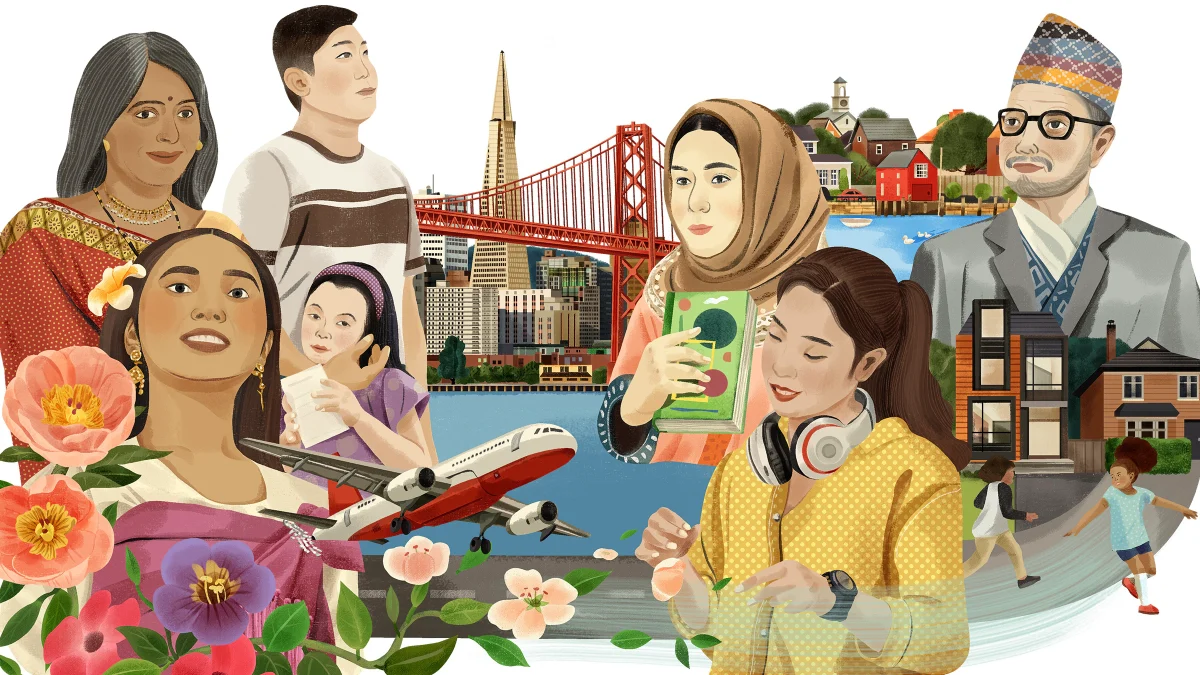In literature, tropes are themes, motifs, or clichés that are commonly seen. They are often easily recognizable and predictable, though that is not always the case. Sometimes creators find it difficult to create a genuinely original and intriguing story due to the overuse of specific tropes. There are many, many different tropes, most of which have self-explanatory names.
Romantic Tropes
Love Triangle
There are numerous variations to this trope. Three characters are oddly involved in a romantic situation. The classic is where two guys pine after this girl and they verbally, physically, and/or emotionally fight for her affection. Sometimes the guys are enemies and sometimes they are/were friends. Other times, one of the guys is obvious and the other is very shy, or one is plain obsessed and the other is very discreet. The point is to navigate and balance romantic and plantic emotions towards love interests and friends. Tension is created and loyalty is tested. For example, in Twilight, Bella struggles with choosing between Edward and Jacob because she has feelings for both of them. Eventually, she chooses Edward and remains friends with Jacob. Love triangles are a type of love web, as more than three people can be connected in conflicting romantic feelings.
Enemies/Rivals/Friends to Lovers
Enemies to lovers has the potential to be one of the most emotionally impactful and dramatic tropes. It could be something like those fantasy novels where two magic warlords have been enemies for hundreds of years turning into lovers, or just two lawyers in the same firm disliking each other at first but then starting to warm up to each other. In the latter example, however, that is more of a rival to lovers, because they aren’t exactly enemies, they’re just competing against each other for a shared goal. Friends to lovers stories are sweeter because there are two people with an already good relationship, except they’re struggling with new and different feelings. There are a lot of internal conflicts, usually over whether the feelings are romantic or not, followed by “the other person definitely doesn’t feel the same and I don’t want to ruin the friendship.” So then they try to act “normal” but everything gets revealed anyway. There’s usually a happy ending. For example, in Clueless, Cher and Josh are sort of kind of rivals, but throughout the movie, they grow closer, and eventually, they start dating.
Lovers/Friends to Enemies
Similarly to the above trope, lovers or friends to enemies have extreme potential to be one of the most—if not the most—dramatic and emotional tropes. Just imagining it creates a feeling similar to wonder. How could two people who were so close to each other become enemies? These stories involve betrayal, deep emotional conflict, and irreparable mistakes. Sometimes the characters feel regretful, but other times they just feel burning hate until one of them dies or they both die.
Forbidden Love/Secret Relationship
There are many reasons why two people would be discouraged from having a romantic relationship. They may struggle with keeping their relationship a secret or from external conflicts with other people keeping them distanced from each other. The most famous example would probably be Romeo and Juliet, who were kept apart by their warring families.
Damsel in Distress
This trope was more commonly used in the past and is often discouraged in modern times. It shows a female character as vulnerable and in need of rescuing, so then there’s a knight in shining armor that saves her from the big bad villain. Then they fall in love, get married, and live happily ever after. This trope is usually in fairy tales, superhero comics, or folklore/myths.
Lover’s Betrayal
Either through cheating or just good old deceit, characters navigate through being deeply hurt by a supposed loved one. There are struggles within the relationship or the character decides that the relationship is over.
Forced Proximity
Characters are forced to spend time with each other. Whether it’s being quarantined together, or forced to work on a project together, or trapped on a deserted island after a plane crash, they can form connections that eventually lead to a romantic relationship. This trope does not necessarily have to be romantic; friendships could also form under forced proximity.
Opposites Attract
Characters that seem to be opposites (sun/moon personality, cat/dog personality, fire/ice personality, extrovert/introvert, opposite MBTIs, etc.) get to know each other and form romantic bonds. Through these stories, the audience takes an interest in the contrasting values between the two. It’s fascinating to see how vastly unique people can form such a close and special relationship.
Fake Relationship
For whatever reason, whether a misunderstanding, to fool someone else, to win a bet, for social status, etc., two people pretend to be dating/have feelings for each other. In reality, they didn’t at first or only one of them did. In the end, they fall for each other. It could also be where two people have to pretend to be friends and thus spend time together (forced proximity), and then they proceed to fall in love, as is the plot for Red, White, and Royal Blue.
Marriage of Convenience
Characters are in a relationship for practicality. They don’t love each other, at least not at first. Plenty of these stories take place in a different period or universe, where marriages for political power, alliances, money, or social status remain popular. Similarly to the above trope, the characters often end up actually falling in love and having a happily ever after.
Slow/Fast Burn
This refers to the pacing of the relationship between two characters. Slow burn is when the relationship is developed at a slow and the fast burn is the opposite. Slow burn uses more tension, inner conflict, and hesitation. There could be external conflict contributing to the slowness of the growth of the relationship. For fast burn, the emotions are more intense and can lead to rash and unreasonable decisions. However, creators must be careful because fast burns could feel sloppy and rushed, while slow burns could feel like an excuse to have characters “break up” and “get back together” numerous times.
Love at First Sight
This is a very classic example of a love trope. These tropes are often fast-burn, where two characters see or meet each other and immediately fall in love. They feel an intense connection at first, leading to a whirlwind of emotions and conflicts, whether internal or external. Is the connection love, or is it obsession? Everyone is saying that it happened too fast; are they right?
Soulmates
These take place in alternate realities where people are somehow destined and fated to be something of a “perfect” match for each other. With work and effort, they should be able to live happily ever after.
Unrequited Love
A character has romantic feelings for someone who does not return those feelings. If the character confesses, it can lead to an awkward friendship. If the character does not confess yet still knows the feelings are unreciprocated, then they are anguished and feel longing. This trope can also result in an odd love web, which happens more often in real life than in literature, where there are a string of people dealing with unrequited love. Person A likes Person B, but B likes C, but C likes D, and so on.
Other Common Tropes
Unreliable Narrator
The narrator is not completely trustworthy, whether purposely or not. In To Kill A Mockingbird, the narrator is a young child at first, so her memory and understanding of events are not the most accurate. In other stories, the narrator is purposely unreliable to manipulate or fool the audience into believing specific ideas.
Chosen One
The most famous example would be Harry Potter, who was nicknamed “The Chosen One.” This is when a character is “chosen,” usually by a prophecy or some type of magic, to be a hero and somehow save the world. Like the soulmate trope, the character is destined to achieve a specific, noble goal. Usually, the character faces plenty of obstacles and comes from a humble background.
Rags to Riches
A poor character, usually also in other states of misfortune, rises to the top and achieves success through good or bad efforts. The character could be an honest person who tried their best and earned money or someone who got lucky and conned the right people.
The Underdog
A character or characters that are at a disadvantage from the start, but similarly to the above trope, they work hard and achieve success. They have to persevere through tough obstacles, usually put there by the opposing side, but they win in the end. These types of events often happen in real life and not just in literature: a rookie defeats the world champion, a politician gets elected even with mass opposition, an artist said to be “untalented” earns millions of dollars from their artwork, etc.
Anti-Hero/False Hero
An anti-hero is a hero but without the conventional characteristics of a hero. They usually have a flawed moral compass and maybe a hero for selfish reasons. Severus Snape was a man with flawed views and he committed cruel acts, but he was a double agent for Dumbledore because of his love/obsession with Lily Potter. He worked for the “good side” but was not honorable. Anti-hero’s actions are morally gray and could be debated about in a moral discussion. A false hero, however, is just someone pretending/trying to be a hero by exhibiting heroic qualities like selflessness and sacrifice. They might commit good acts with questionable motivations or with deceitful intentions.
The Quest/Prophecy
Similarly to the “Chosen One” trope, this trope is when characters go on a journey or adventure to fulfill a specific request. The characters face physical and mental obstacles, and could also be forced to navigate relationship (platonic and romantic) issues as well as mental struggles.
Reluctant Hero
A character needs to be the hero, except the character does not want to. They are either unwilling or unsure to take on the role of a hero. They could have doubts about their abilities or just not want the responsibility. However, through persuasion, a sense of duty, and a sense of morality, the character eventually accepts and takes on the role.
Evil Twin
The two characters are extremely similar in terms of personality traits and values, just very different executions to achieve the same goals. It’s usually the protagonist and antagonist who are evil twins, who are also foils to each other.
The Outsider
Often occurring in real life, a character is excluded from types of groups of people due to reasons like their background, race, religion, gender, beliefs, differences, etc. The person could struggle to emotionally connect with other characters because of their vast differences in perspective.
Femme Fatale
Somewhat the opposite of the damsel in distress trope, this is when a female manipulates a man’s feelings and actions for her benefit. Usually, the man ends up dealing with large emotional consequences, as well as his downfall and unfortunate ending.
The Mentor/Old Wise Person
Many people have role models, and fictional characters are no different. Often, an old wise mentor figure will guide the character through challenging situations. The mentor is the source of valuable advice and wisdom that the protagonist uses to overcome challenges.
Amnesia
A character loses their entire memory or a part of it. In the movie Anastasia, Anastasia forgets that she’s a princess after falling and hitting her head. Falling and hitting one’s head is one of the most common reasons for amnesia in literature. Other times, magic is the reason why someone’s memory is scattered or incomplete. This trope allows characters to go through identity struggles and revelations. They put together their past and make discoveries about who they were. Sometimes, depending on the situation, the character’s past can come back to haunt them, which is made worse by the fact that they don’t even remember what exactly happened.
Redeemed Villain/Redemption Arc
A villainous character tries to make themself a better person, either by making up past mistakes or just doing better in general. A redemption arc does not necessarily have to be of a villain; it could also be for a character that previously failed something or made an honest mistake that led to consequences.
Found Family
Individuals who usually don’t have a good family or a blood family at all come together, and through shared experiences and goals, they form an extremely strong bond that makes them as close as blood relatives. In Six of Crows, six teenagers are very different from each other and are all outcasts in their own ways, but somehow, through working together in an insanely complicated and dangerous heist, they get to know each other more and form invaluable lifelong connections.
Comic Relief
In any story, having each scene be tension-filled, serious, and/or dramatic makes it boring and perhaps stressful for audiences to watch or read. Therefore, some type of comic relief is needed, either through a humorous sidekick/best friend or random extras doing humorous things. Stories aren’t just about listing events; they’re made for entertainment. Stories also need contrast to be interesting. Comic relief is usually always needed, it’s just that the trope of “that one friend who is there for diversity and only is there to crack jokes to relieve tension and be funny” is greatly overused, basic, and unoriginal.
Uncommon Tropes
Unreliable Antagonist
An antagonist where their motivations and goals are unclear or inconsistent, creates doubts and uncertainty about if the villain is actually a villain or if they secretly have other hidden agendas.
Unreliable Environment
Usually, this deals with fantasy/magical environments with elements such as time-warping, traveling through parallel universes, hallucinations/illusions, etc. The unpredictability of the environment usually works against the protagonists.
Inconvenient Power
The protagonist has powers, except it’s not a good thing. It may seem like so at first, but there are unintended or unforeseen consequences. The character could find out too late that the power is uncontrollable or has vast drawbacks.
Failed Redemption
A character attempts to redeem themselves, but it fails. Sometimes time constraints lead to this failure. Usually, it’s a former villain trying for redemption either for their own benefit or because they want to become a better person. The consequence is sometimes devastating and there is a theme revolving around how one’s past could come back to haunt them.
Unseen Villain
An ambiguous and vague force works against the protagonist. They are never directly shown or revealed and may already be gone or dead, but are still somehow opposing the protagonist. It could be someone like an extremely mysterious mafia boss or a thing like the spells a dead sorcerer lord cast hundreds of years ago.
Collective Protagonist
Instead of only one protagonist, multiple characters go through arcs and developments, all equally contributing to the plot and its progression. In Heroes of Olympus, seven characters share the weight of a prophecy to save the world. They all individually have character arcs, but they are connected by the prophecy and in their combined efforts to overcome trials and tribulations to prevent Gaea from overthrowing the rulers of Olympus. Although not all seven were narrators in the same book, that does not necessarily mean they were less relevant.
Mentor Betrayal
A mentor figure that had emotional connections with the protagonist betrays them in some way. Since these two had a close relationship, it comes as a shock and allows the protagonist to have inner turmoil about trusting those close to them. The protagonist usually doubts and re-evaluates the advice given by the mentor and has increased self-doubt, due to trusting someone who was not to be trusted.
Breaking the Fourth Wall
Mostly done in movies and shows and not in books, the character acknowledges that they are in a story. In movies, maybe the actor will look directly at the camera while everything else freezes and make a short comment about the scene that is currently taking place, or make a reference to the fact that they are an actor and not the character. In dramas and plays, occasionally actors will react to an occurrence from the audience, like a ringing cell phone or a whiny child.
Narrative Maze
The plot is purposefully made to be intricate and complex to challenge and confuse the audience. Perhaps there are contradictions in the narration due to unreliable narrators. The plot is supposed to be layered with deception and misdirection.
Memory Palace
A character goes through a mental palace where each room is a memory. This is often a coping mechanism after someone has been through a lot of trauma or grief. As the character goes through more and more rooms, their backstory or explanatory events from their past are revealed, allowing the audience to see more layers and explanations of their personality. The journey itself, as in how the character reacts to the memories, also adds more depth and development to the character.
Ending Tropes
Happy Ending
Due to a positive outcome, the characters are happy. The protagonist has succeeded in whatever their journey was about and the conflict is resolved. The overall mood is positive. Children’s stories often get happy endings: Cinderella finds her Prince Charming and they get married, at the end of Toy Story Buzz and Woody are happily friends again, and Nemo and Marlin are happily reunited at the end of Finding Nemo.
Sad Ending
Due to a negative outcome, the characters are sad. The protagonist has failed in achieving the goal and the conflict remains or is worsened. Sometimes, major characters die or suffer equally grave consequences. The overall mood is negative. One might say the ending of Shakespeare’s Romeo and Juliet was tragic, and that’s true, as it could cause readers to feel sorrowful and distressed. Technically, however, it is classified as a sad ending as it was only misfortune and circumstance that caused their deaths. The ending is also somewhat bittersweet, as the Montagues and Capulets resolve to end their conflict.
Tragic Ending
Similarly to a sad ending, there is a negative outcome. However, these types of endings focus more on the downfall of characters due to internal flaws, unforeseen consequences, or events beyond their control. In Shakespeare’s Hamlet, Hamlet goes through a mental downfall due to the countless betrayals and deceit throughout the story. His actions lead to the deaths of almost all of the main characters.
Bittersweet Ending
The mood is complex, with both happy and sad emotions mixed. There is some level of success combined with a degree of failure. Or, the protagonist has succeeded, just at a huge cost. This often creates a mood of melancholy and regret. In Harry Potter and the Deathly Hallows, Voldemort was defeated, but plenty of beloved characters were dead. In Titanic, the story is a flashback from Rose’s youth, where she reminisces about her happy times with Jack. However, he died, so not everything ended well.
Open/Ambiguous Ending
Open endings are where the story ends in a way that allows the audience to have multiple reasonable interpretations of what could happen next. In The Hunger Games trilogy, Kainiss’ conflicts are resolved and she is in a good state of mind. However, the future of Panem is uncertain due to her act of rebellion and the turmoil from the past years. Ambiguous endings are similar, except they are created in a way that generates uncertainty and maybe confusion about following events. The outcome is uncertain. In The Polar Express, the protagonist returns home after all his adventures. However, the events have many elements of fantasy and it is left unclear if these events actually occurred or if it was just a part of his imagination, or if he was just dreaming. Both are not “proper” resolutions, as there are often loose ends left.
Twist Ending
Plot twists are fairly common, but usually, they are not towards the end. Twist endings are different from other plot twists as the audience has learned of most of the events in the story, so twist endings can greatly shift the audience’s perception of a character, an event, or anything else from the story. In the murder mystery novel And Then There Were None, how the murderer succeeded was revealed in a letter at the very end, in what is known as one of the most famous plot twists in mystery novels.
Cliffhanger Ending
The story ends at or right after the climax. Usually, the falling action follows the climax, but here there is no falling action. The climax is dramatic but that’s where the story stops. The audience always has speculations about possible events and is itching to find out more. Occasionally, stories in a series end at a cliffhanger to keep the audience’s interest for the next book/movie/episode in the series. Often, a cliffhanger ending is a result of a twist ending. In Game of Thrones, the shocking death of a character leaves the audience wondering about the events of the next season.
Most works of literature employ more than one trope, and many tropes go hand-in-hand. As long as they are not overused or put in a story to seem cool, then creators should feel free to use whichever trope however and whenever they wish. Tropes give stories a sense of relatability, but should not be basic and predictable.






